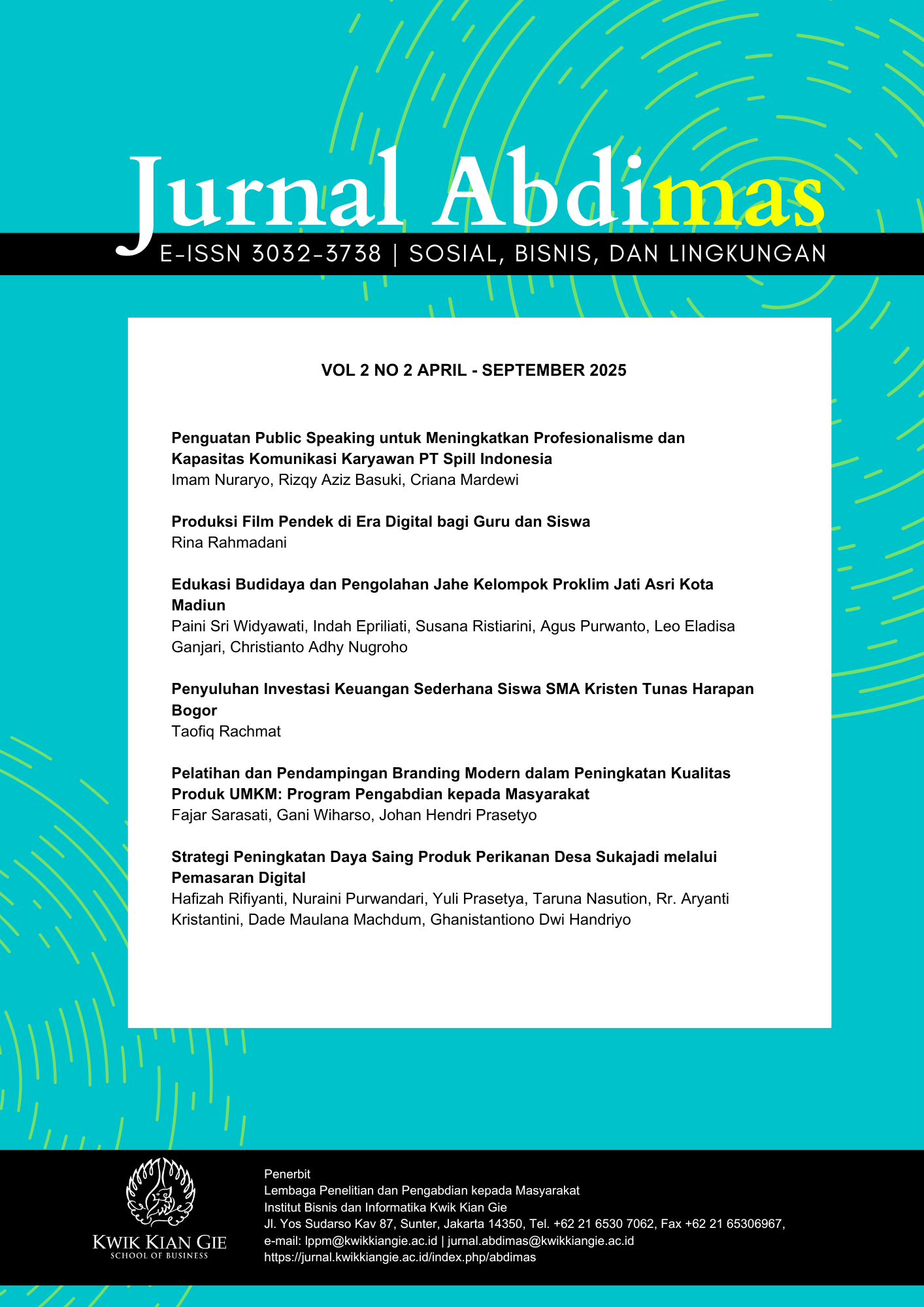Produksi Film Pendek di Era Digital bagi Guru dan Siswa
Main Article Content
Abstract
Rapid advancement of communication technology has brought both opportunities and challenges for the short film industry in Indonesia. With the increasing accessibility of digital tools, particularly smartphones, individuals, especially youth, can produce short films at relatively low costs. Furthermore, the digital era offers a variety of platforms for showcasing these films to broad audiences, which has led to a growing interest in short film production nationwide. In response, short films are increasingly recognized by established production houses as a medium for talent discovery and creative experimentation. However, despite the ease of access to technology, developing skilled and creative young filmmakers remains a considerable challenge. Therefore, structured training programs for high school and vocational students have become essential. These initiatives are not only a form of community engagement by higher education institutions but also a strategic effort to contribute to the growth of Indonesia’s creative industry, particularly in the area of short filmmaking. The training emphasizes a comprehensive approach, combining theoretical knowledge with practical experience. Students are guided through the complete production process, from pre-production to post-production utilizing modern digital technologies to enhance their technical and creative skills, thereby preparing them to participate meaningfully in the evolving landscape of digital film production.
Downloads
Article Details

This work is licensed under a Creative Commons Attribution-NonCommercial-ShareAlike 4.0 International License.
References
Alfathoni, Muhammad Ali Mursid and Mahesah, D. (2020). PengantarTeori Film (1st ed.). Yogyakarta: Deepublish.
Komara, L. H. (2021). Potensi Film Pendek Di Era Internet. IKONIK : Jurnal Seni Dan Desain, 3(2), 48. https://doi.org/10.51804/ijsd.v3i2.998
Meisyaroh, S., Esra, M. A., & Dasawaty, E. S. (2024). Strategi Pemasaran Digital untuk UMKM dalam Aktivitas Ekspor ke Singapura. Jurnal Abdimas: Sosial, Bisnis, Dan Lingkungan, 1(2), 57–62. https://doi.org/10.46806/abdimas.v1i2.1116
Nuraryo, I., Basuki, R. A., & Mardewi, C. . (2025). Penguatan Public Speaking untuk Meningkatkan Profesionalisme dan Kapasitas Komunikasi Karyawan PT Spill Indonesia. Jurnal Abdimas: Sosial, Bisnis, Dan Lingkungan, 2(2), 48–57. https://doi.org/10.46806/abdimas.v2i2.1390
Nuraryo, I., Meisyaroh, S., & Suatmi, B. D. (2023). Pelatihan Strategi Merancang Video Iklan Promosi Produk UMKM dalam Media Sosial. Jurnal Abdimas: Sosial, Bisnis, Dan Lingkungan, 1(1), 40–47. https://doi.org/10.46806/abdimas.v1i1.1076
Parady, Rayhan and A, D. (2024). Peluang Sineas Film Indonesia Berkompetisi dalam Memproduksi Film Pendek Berkualitas. Ditjen Kebudayaan. Retrieved from https://www.kemdikbud.go.id/main/blog/2024/03/peluang-sineas-film-indonesia-berkompetisi-dalam-memproduksi-film-pendek-berkualitas
Rahmadani, R. (2025). Pelatihan Jurnalisme Televisi di Era Digitalisasi dan Konvergensi. Jurnal Abdimas: Sosial, Bisnis, Dan Lingkungan, 2(1), 40–47. https://doi.org/10.46806/abdimas.v2i1.1366
Tempo. (2022). Bangkitnya Marwah Film Pendek (1st ed.; Pusat Data dan Analisa Tempo, ed.). Jakarta: Pusat Data dan Analisa Tempo. Retrieved from www.datatempo.co
Wandira, L. (2025). Industri Film Indonesia Diprediksi Menjanjikan di 2025, Lebih 150 Judul Bakal Tayang. Kontan.
